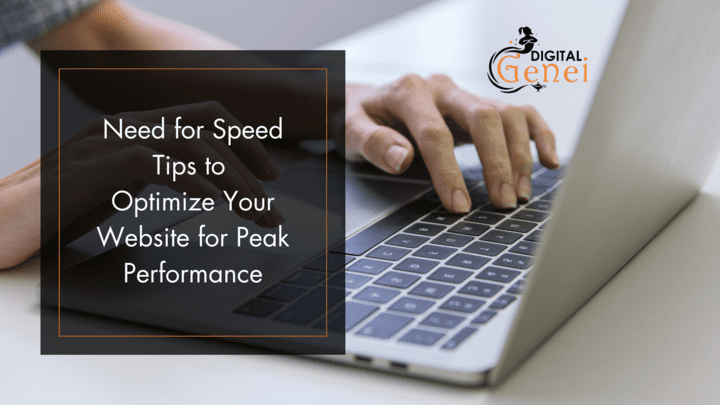In the fast-paced digital landscape, speed is not just a luxury; it’s a necessity. A slow-loading website can deter visitors, impact user experience, and even affect search engine rankings. To ensure your website performs at its peak, optimizing for speed is paramount. Let’s explore essential tips to turbocharge your website and deliver a seamless, lightning-fast experience to your users.
Image Optimization: The Weight of Visuals
A picture is worth a thousand words, but it's the load time that counts.
-Jeffrey Veen
Images play a crucial role in web design, but their file sizes can significantly impact loading times.
- Compress Images:
Use image compression tools to reduce file sizes without compromising quality. This minimizes the data that needs to be transferred, speeding up image loading on your website.
- Choose the Right File Format:
Selecting the appropriate file format for images is key. Use JPEG for photographs, while PNG is ideal for transparent graphics and images. SVG is a great option for vector images.
Browser Caching: Serving Repeat Visitors Faster
“Don’t make me call the cache,” joked every website visitor. Browser caching allows your website to store static files on a visitor’s device, enabling faster loading upon subsequent visits.
- Set Expires Headers:
Configure your server to set expiration dates for static resources. This prompts browsers to store these resources locally, reducing the need to re-download them on subsequent visits.
- Utilize Cache-Control:
Implement the Cache-Control header to specify how long a resource should be cached. This provides more control over the caching duration and enhances website speed.

- Content Delivery Network (CDN): Globally Accelerating Content
“Speed knows no boundaries,” and neither should your website. A Content Delivery Network (CDN) distributes your website’s static content across multiple servers worldwide, reducing latency for users across the globe.
- Distribute Content Strategically:
Use a CDN to strategically distribute content, such as images, stylesheets, and scripts, to servers geographically closer to users. This minimizes the physical distance data must travel, resulting in faster loading times.
- Leverage CDN Providers:
Choose a reliable CDN provider that aligns with your website’s needs. Popular CDN services include Cloudflare, Akamai, and Amazon CloudFront.
Minification: Trim the Excess
“Less is more” holds in the digital realm. Minification involves removing unnecessary characters and spaces from your website’s code, reducing file sizes, and speeding up loading times.
- Minify CSS, JavaScript, and HTML:
Utilize minification tools to strip unnecessary characters, whitespace, and comments from CSS, JavaScript, and HTML files. This results in leaner code that loads faster.
- Remove Unused Code:
Regularly audit your website’s codebase to identify and remove unused or redundant code. Unnecessary elements contribute to increased loading times.
Optimize Server Performance: The Heart of Speed
“A well-tuned server is a symphony to the user,” noted an anonymous server enthusiast. Optimizing your server is foundational to achieving top-notch website performance.
- Choose a Reliable Hosting Provider:
Select a hosting provider that aligns with your website’s needs. Consider factors like server location, uptime guarantees, and scalability.

- Enable Compression:
Enable server-side compression, such as GZIP or Brotli, to reduce the size of transmitted data. This significantly decreases loading times, especially for text-based resources.
Mobile Optimization: Accelerating On-the-Go Experiences
Life is mobile; your website should be too.
- Josh Clark
With a growing number of users accessing websites on mobile devices, optimizing for mobile speed is crucial.
- Responsive Design:
Implement a responsive design that adapts seamlessly to various screen sizes. This ensures that mobile users experience fast loading times without sacrificing content quality.
- Prioritize Above-the-Fold Content:
Optimize the loading of above-the-fold content, the portion visible without scrolling. Prioritizing this content ensures that users get a swift and engaging experience while the rest of the page loads.
Monitor and Analyze: Continuous Improvement
“To improve is to change; to be perfect is to change often,” echoed Winston Churchill. Regularly monitor your website’s performance, analyze user behavior, and make data-driven decisions for continuous improvement.
- Use Performance Monitoring Tools:
Leverage tools like Google PageSpeed Insights, GTmetrix, or Pingdom to assess your website’s performance. These tools provide insights and recommendations for improvement.
- User Analytics:
Dive into user analytics to understand how visitors interact with your website. Identify high-traffic pages, entry points, and potential bottlenecks to tailor your optimization efforts effectively.
Conclusion: A Need for Speed in the Digital Race
In the competitive digital landscape, a need for speed is not just about ranking higher on search engines; it’s about providing users with a seamless and enjoyable experience. By embracing image optimization, leveraging browser caching and CDNs, practicing minification, optimizing server performance, focusing on mobile experiences, and continuously monitoring and analyzing performance, your website can achieve peak speed and performance. Remember, a faster website isn’t just an advantage in the digital race—it’s the winning edge.





